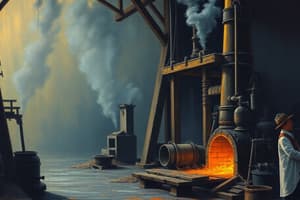Podcast
Questions and Answers
What effect does phosphorus have on steel?
What effect does phosphorus have on steel?
- Enhances ductility
- Improves surface finish
- Causes brittleness at low temperatures (correct)
- Increases toughness
How does carbon affect the properties of steel?
How does carbon affect the properties of steel?
- Reduces machinability only
- Decreases strength and hardness
- Has no significant effect
- Increases hardness and strength (correct)
What is a primary effect of manganese when alloyed with steel?
What is a primary effect of manganese when alloyed with steel?
- Improves machinability
- Enhances corrosion resistance
- Improves toughness (correct)
- Reduces brittleness
When does carbon start causing brittleness in cast iron?
When does carbon start causing brittleness in cast iron?
What does chromium add to steel's properties?
What does chromium add to steel's properties?
What negative effect does oxygen have on steel?
What negative effect does oxygen have on steel?
What is the primary benefit of using continuous casting with electromagnetic stirring?
What is the primary benefit of using continuous casting with electromagnetic stirring?
Which element enhances both strength and ductility in steel?
Which element enhances both strength and ductility in steel?
What is one of the main advantages of using epoxy resin composites in marine engineering?
What is one of the main advantages of using epoxy resin composites in marine engineering?
What function does the matrix serve in a fiber-reinforced composite?
What function does the matrix serve in a fiber-reinforced composite?
Which type of adhesive would be most suitable for sealing deck seams exposed to UV light and saltwater?
Which type of adhesive would be most suitable for sealing deck seams exposed to UV light and saltwater?
What is NOT a typical application of epoxy adhesives in marine engineering?
What is NOT a typical application of epoxy adhesives in marine engineering?
Which component in a fiber-reinforced composite does NOT contribute to strength and stiffness?
Which component in a fiber-reinforced composite does NOT contribute to strength and stiffness?
What property makes silicone adhesives particularly effective for sealing applications?
What property makes silicone adhesives particularly effective for sealing applications?
For which application is cyanoacrylate (super glue) prominently used?
For which application is cyanoacrylate (super glue) prominently used?
What step is essential for the effective use of adhesives in marine applications?
What step is essential for the effective use of adhesives in marine applications?
What is produced when carbon monoxide reacts with iron ore in the steelmaking process?
What is produced when carbon monoxide reacts with iron ore in the steelmaking process?
Which element is essential for producing pig iron from iron ore in a blast furnace?
Which element is essential for producing pig iron from iron ore in a blast furnace?
What is the primary purpose of the Basic Oxygen Furnace (BOF)?
What is the primary purpose of the Basic Oxygen Furnace (BOF)?
Which chemical reaction occurs when limestone decomposes in the steelmaking process?
Which chemical reaction occurs when limestone decomposes in the steelmaking process?
What is one of the problematic elements in steel refining that contributes to brittleness?
What is one of the problematic elements in steel refining that contributes to brittleness?
What is the byproduct formed when calcium oxide reacts with silicon dioxide in the steelmaking process?
What is the byproduct formed when calcium oxide reacts with silicon dioxide in the steelmaking process?
In an Electric Arc Furnace (EAF), what material is primarily melted?
In an Electric Arc Furnace (EAF), what material is primarily melted?
During the steel refining process, which methods are used to adjust the chemical composition of molten steel?
During the steel refining process, which methods are used to adjust the chemical composition of molten steel?
What is the primary purpose of cleaning the surface before applying adhesive?
What is the primary purpose of cleaning the surface before applying adhesive?
Why is it important to dry the surface thoroughly before adhesive application?
Why is it important to dry the surface thoroughly before adhesive application?
What is the primary purpose of the hot rolling process?
What is the primary purpose of the hot rolling process?
What advantage do adhesives have in marine applications?
What advantage do adhesives have in marine applications?
Which treatment uses heating to relieve residual stresses without reaching the recrystallization point?
Which treatment uses heating to relieve residual stresses without reaching the recrystallization point?
What is the effect of the annealing process on metals?
What is the effect of the annealing process on metals?
What is a limitation of adhesives that must be considered?
What is a limitation of adhesives that must be considered?
What is the main consequence of the hardening process?
What is the main consequence of the hardening process?
Which testing method evaluates a material's resistance to surface indentation?
Which testing method evaluates a material's resistance to surface indentation?
Which process primarily aims to improve toughness after hardening?
Which process primarily aims to improve toughness after hardening?
Which of the following is NOT a method of destructive testing?
Which of the following is NOT a method of destructive testing?
What type of testing uses sound waves to identify internal flaws in a material?
What type of testing uses sound waves to identify internal flaws in a material?
Which of the following metals commonly undergoes the quenching process?
Which of the following metals commonly undergoes the quenching process?
What characteristic does normalizing primarily aim to achieve in metals?
What characteristic does normalizing primarily aim to achieve in metals?
What does fatigue testing measure in materials?
What does fatigue testing measure in materials?
What is a key outcome of the cold rolling process?
What is a key outcome of the cold rolling process?
What is a primary advantage of using aluminum-magnesium alloys in marine applications?
What is a primary advantage of using aluminum-magnesium alloys in marine applications?
Which of the following is NOT a common application of copper-nickel alloys?
Which of the following is NOT a common application of copper-nickel alloys?
What key property makes titanium alloys suitable for extreme marine environments?
What key property makes titanium alloys suitable for extreme marine environments?
Which property is critical for an alloy to ensure it can withstand mechanical stresses in marine applications?
Which property is critical for an alloy to ensure it can withstand mechanical stresses in marine applications?
What is a significant feature of bronze (copper-tin alloy) in marine systems?
What is a significant feature of bronze (copper-tin alloy) in marine systems?
Which of the following does NOT contribute to the selection of an alloy for marine applications?
Which of the following does NOT contribute to the selection of an alloy for marine applications?
Which non-ferrous alloy is known for its superior resistance to biofouling?
Which non-ferrous alloy is known for its superior resistance to biofouling?
What key property is essential for ensuring improved fuel efficiency in marine structures?
What key property is essential for ensuring improved fuel efficiency in marine structures?
Flashcards
Phosphorus in Steel
Phosphorus in Steel
Phosphorus in steel causes it to become brittle, especially at low temperatures, making it less durable.
High Carbon Steel
High Carbon Steel
High carbon content makes steel hard and strong but also brittle, difficult to weld, and hard to machine.
Oxygen in Steel
Oxygen in Steel
Oxygen in steel weakens it, makes it rust easily, and causes imperfections like holes.
Manganese in Steel
Manganese in Steel
Signup and view all the flashcards
Chromium in Steel
Chromium in Steel
Signup and view all the flashcards
Nickel in Steel
Nickel in Steel
Signup and view all the flashcards
Continuous Casting with Electromagnetic Stirring
Continuous Casting with Electromagnetic Stirring
Signup and view all the flashcards
Casting Techniques
Casting Techniques
Signup and view all the flashcards
Basic Oxygen Furnace (BOF)
Basic Oxygen Furnace (BOF)
Signup and view all the flashcards
Electric Arc Furnace (EAF)
Electric Arc Furnace (EAF)
Signup and view all the flashcards
Ladle Refining
Ladle Refining
Signup and view all the flashcards
Sulfur in Steel
Sulfur in Steel
Signup and view all the flashcards
Iron
Iron
Signup and view all the flashcards
Blast Furnace
Blast Furnace
Signup and view all the flashcards
Oxidation in Steelmaking
Oxidation in Steelmaking
Signup and view all the flashcards
Blast Furnace Charge
Blast Furnace Charge
Signup and view all the flashcards
Composites
Composites
Signup and view all the flashcards
Fiber-Reinforced Composites
Fiber-Reinforced Composites
Signup and view all the flashcards
Matrix (Binder)
Matrix (Binder)
Signup and view all the flashcards
Adhesives
Adhesives
Signup and view all the flashcards
Epoxy Adhesive
Epoxy Adhesive
Signup and view all the flashcards
Polyurethane Adhesive
Polyurethane Adhesive
Signup and view all the flashcards
Cyanoacrylate Adhesive (Super Glue)
Cyanoacrylate Adhesive (Super Glue)
Signup and view all the flashcards
Silicone Adhesives
Silicone Adhesives
Signup and view all the flashcards
Normalizing
Normalizing
Signup and view all the flashcards
Non-ferrous alloys
Non-ferrous alloys
Signup and view all the flashcards
Aluminum-Magnesium Alloys
Aluminum-Magnesium Alloys
Signup and view all the flashcards
Copper-Nickel Alloys
Copper-Nickel Alloys
Signup and view all the flashcards
Bronze (Copper-Tin Alloy)
Bronze (Copper-Tin Alloy)
Signup and view all the flashcards
Titanium Alloys
Titanium Alloys
Signup and view all the flashcards
Corrosion Resistance
Corrosion Resistance
Signup and view all the flashcards
Weight
Weight
Signup and view all the flashcards
Hot Rolling
Hot Rolling
Signup and view all the flashcards
Cold Rolling
Cold Rolling
Signup and view all the flashcards
Stress Relief Treatment
Stress Relief Treatment
Signup and view all the flashcards
Annealing
Annealing
Signup and view all the flashcards
Hardening
Hardening
Signup and view all the flashcards
Tempering
Tempering
Signup and view all the flashcards
Quenching
Quenching
Signup and view all the flashcards
Surface Preparation
Surface Preparation
Signup and view all the flashcards
Roughening the Surface
Roughening the Surface
Signup and view all the flashcards
Verify Compatibility
Verify Compatibility
Signup and view all the flashcards
Apply in Proper Conditions
Apply in Proper Conditions
Signup and view all the flashcards
Destructive Testing (DT)
Destructive Testing (DT)
Signup and view all the flashcards
Non-destructive Testing
Non-destructive Testing
Signup and view all the flashcards
Ultrasonic Testing (UT)
Ultrasonic Testing (UT)
Signup and view all the flashcards
Radiographic Testing (RT)
Radiographic Testing (RT)
Signup and view all the flashcards
Study Notes
Steelmaking Process
- The key element in steelmaking is iron
- Pig iron (molten iron) is produced in a blast furnace at 2000°C
- Iron ore, coke, and limestone are mixed
- The blast furnace has different temperature zones
- Hot air reacts with coke, producing carbon dioxide (CO2)
- Carbon dioxide reacts with remaining coke, producing carbon monoxide (CO).
- Carbon monoxide reacts with iron ore, creating molten iron (pig iron) and carbon dioxide
- Limestone decomposes to form slag, which combines with silicon dioxide (sand)
Steel Refining Processes
- Basic Oxygen Furnace (BOF) removes excess carbon by oxidizing molten iron
- Electric Arc Furnace (EAF) is used for recycling scrap metal
- Ladle refining adjusts the chemical composition of molten steel
- Problematic elements in steel include sulphur, phosphorus, carbon and oxygen
Detrimental Elements
- Sulfur contributes to hot shortness (brittleness) at high temperatures, and cold shortness (brittleness) at low temperatures. It also reduces toughness.
- Phosphorus causes cold shortness and reduces toughness
- Carbon causes brittleness, reduced weldability, and difficult machinability
- Oxygen reduces strength and toughness; causes poor surface finish, increased porosity and casting defects.
Effects of Alloying Elements
- Carbon increases hardness and strength
- Manganese improves toughness
- Chromium adds corrosion resistance
- Nickel enhances strength and ductility, and adds corrosion resistance
Casting Techniques
- Continuous casting with electromagnetic stirring reduces segregation and enhances homogeneity
- Filtered casting removes imperfections and ensures a cleaner melt
Hot and Cold Rolling
- Hot rolling shapes and toughens steel above its recrystallization temperature.
- Cold rolling refines thickness, improves surface quality, and increases strength via strain hardening.
Heat Treatment Processes
- Stress relief heating the metal below its recrystallization temperature relieves residual stresses, improves dimensional stability, and reduces distortion.
- Annealing softens the metal, improves ductility, refines grain structure, and relieves internal stresses.
- Hardening involves heating to a high temperature for austenitization, followed by rapid cooling, increasing hardness and strength, but reducing ductility.
- Tempering reheats hardened metal to a lower temperature to reduce brittleness, improve toughness, and balance hardness with ductility.
- Quenching rapidly cools a metal after heating to create a hard microstructure (e.g., martensite).
Non-Ferrous Metals and Alloys
- Non-ferrous alloys do not contain significant amounts of iron.
- They are used in marine engineering due to corrosion resistance, lightweight nature, and strength.
- Common examples include aluminum-magnesium alloys, copper-nickel alloys, bronze, and titanium alloys.
Plastics, Rubbers, and Composites in Marine Applications
- Plastics are lightweight, corrosion resistant and versatile for marine applications
- Types of plastics commonly used include polyethylene terephthalate (PET), polyvinyl chloride (PVC), polytetrafluoroethylene (PTFE), and polypropylene (PP).
- Advantages include lightweight, resistance to corrosion, and easy shape and fabrication.
- Disadvantages include susceptibility to UV degradation and mechanical wear, which can be mitigated with coatings or additives.
- Rubbers (elastomers) are used for flexibility, durability, and resistance to harsh marine conditions
- Typical types are natural rubber, neoprene rubber, silicone rubber, and styrene-butadiene rubber (SBR).
- Composites combine a matrix material with reinforcements to achieve superior performance, such as glass-reinforced plastics (GRP), carbon fiber composites, and epoxy resin composites.
Adhesives
- Adhesives are substances that bond two or more surfaces together, providing lightweight, durable, and seamless alternatives to mechanical fasteners.
- Examples include epoxy, polyurethane, cyanoacrylate, silicone, and contact adhesives.
- Surface preparation is critical for proper adhesive bonding
Testing Methods
- Destructive testing damages or destroys material to evaluate mechanical properties like strength, ductility, hardness, toughness, and fatigue.
- Tensile tests measure strength and elongation under tension.
- Hardness tests evaluate resistance to surface indentation.
- Impact tests assess toughness and energy absorption.
- Fatigue tests determine resistance to cyclic loading.
- Bend tests measure ductility and flexural strength.
- Non-destructive testing examines materials without damage, using methods like ultrasonic testing (UT), radiographic testing (RT), magnetic particle testing (MT), dye penetrant testing (PT), and visual testing (VT).
Studying That Suits You
Use AI to generate personalized quizzes and flashcards to suit your learning preferences.




